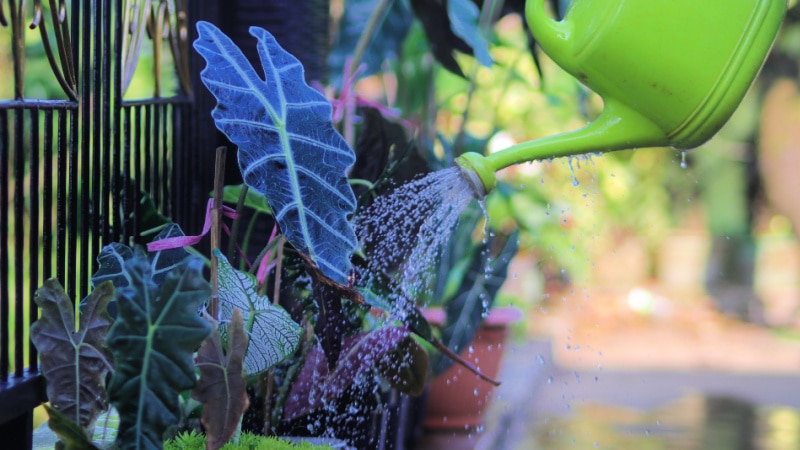Watering & Light Tips for Thriving Alocasia Polly and Chantrieri Plants

Strong 8k brings an ultra-HD IPTV experience to your living room and your pocket.
Alocasia plants have taken the world of indoor gardening by storm with their bold, architectural foliage and tropical appeal. Among the most admired species are the Alocasia Polly and Alocasia Chantrieri - two exotic varieties that bring a unique aesthetic to any indoor plant collection. However, thriving with these tropical beauties requires a good understanding of their specific needs, especially when it comes to watering and lighting. In this blog, we’ll guide you through the best watering and light practices to help your Alocasias flourish.
Understanding Alocasia Polly and Chantrieri
Before diving into care techniques, it's important to understand what makes these plants unique.
Alocasia Polly, also known as African Mask or Elephant Ear plant, is popular for its striking dark green leaves with bold white veining. It’s compact and ideal for indoor spaces, making it a favorite for tabletops or plant shelves.
Alocasia Chantrieri is a rarer variety known for its deep, metallic green leaves with an almost velvety texture. The leaves have a sculptural look that makes this plant a standout in any room. Though a bit more demanding than its Polly counterpart, Chantrieri is highly sought after by plant enthusiasts and collectors.
Despite their differences, both plants share similar requirements when it comes to watering and lighting.
The Importance of Proper Watering
Watering is one of the most critical factors for maintaining healthy Alocasia Polly and Alocasia Chantrieri plants. These tropical plants are native to humid, rain-forested regions and require consistent moisture. However, overwatering can quickly lead to root rot, a common cause of plant decline.
Best Watering Practices:
1. Check Moisture Levels First
Always test the top 1-2 inches of soil before watering. If the soil feels dry, it’s time to water. If it’s still damp, wait a day or two. Avoid letting the soil dry out completely.
2. Use the Right Watering Method
Water thoroughly until it starts to drain from the bottom of the pot. This ensures that the roots receive even hydration. Empty the saucer underneath to prevent the plant from sitting in excess water.
3. Avoid Waterlogged Conditions
Make sure your pot has good drainage. Use a well-aerated soil mix containing perlite or orchid bark to promote airflow and prevent compaction.
4. Adjust Watering Frequency Seasonally
During the growing season (spring and summer), both Alocasia Polly and Alocasia Chantrieri require more frequent watering due to increased evaporation and growth activity. In fall and winter, reduce watering as their growth slows and the plant enters a semi-dormant phase.
5. Watch for Signs of Over or Underwatering
Yellowing leaves and mushy stems usually indicate overwatering, while drooping leaves and dry soil suggest underwatering.
Light Requirements for Optimal Growth
Light is another essential factor for healthy growth. While both Alocasias are adapted to the dappled light of the forest floor in their native environments, indoor conditions can differ significantly.
Light Tips for Alocasia Polly:
• Bright, Indirect Light
Alocasia Polly thrives in bright, filtered light. A spot near an east- or north-facing window is ideal. Direct sun can scorch the leaves, so use sheer curtains if placing it near a south- or west-facing window.
• Artificial Light
If natural light is limited, Polly adapts reasonably well to fluorescent grow lights. Ensure the light is placed 6–12 inches above the plant and keep it on for 10–12 hours daily.
Light Tips for Alocasia Chantrieri:
• Bright, Indirect to Medium Light
Alocasia Chantrieri prefers slightly more subdued lighting compared to Polly. While it can handle moderate light levels, ensure it still gets enough brightness to maintain its vivid coloration and structure.
• Avoid Full Shade or Harsh Light
Too little light may cause the Chantrieri’s growth to slow, and the leaves may lose their luster. On the other hand, intense, direct sun can burn the delicate foliage.
Creating the Ideal Environment
Besides watering and light, creating a supportive environment will elevate your plant care game.
• Humidity Matters
Both Alocasia varieties love high humidity (60% or higher). Use a humidifier or place a water-filled pebble tray near the plant to increase ambient moisture.
• Temperature Control
Keep the room temperature between 65°F and 80°F. Avoid cold drafts and sudden temperature drops, as Alocasias are sensitive to chilly environments.
• Routine Maintenance
Regularly wipe the leaves with a damp cloth to remove dust and allow for better photosynthesis. Also, inspect for pests like spider mites and mealybugs, which can be attracted to the plant's lush leaves.
Conclusion
With the right care, Alocasia Polly and Alocasia Chantrieri can become showstoppers in your indoor plant collection. By mastering their watering needs and providing optimal lighting, you’ll set the stage for vibrant growth and striking foliage display all year round. Whether you’re a beginner or a seasoned plant parent, these two exotic beauties are worth every bit of attention and care.
Note: IndiBlogHub features both user-submitted and editorial content. We do not verify third-party contributions. Read our Disclaimer and Privacy Policyfor details.


